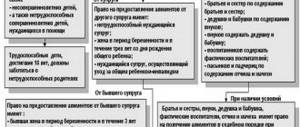5
Being obligated to support his minor children, the parent who left the family (most often the father) does not always have enough funds to pay child support regularly and in full.
The Family Code allows for the establishment of various types of voluntary payment of alimony by agreement, including the transfer of expensive property against future alimony payments. Most often, such property becomes real estate, less often - a vehicle. This method of fulfilling one’s obligations to a child is relevant only for voluntary payment of alimony; it is not used in court.
Basic information
The advantage of drawing up an alimony agreement on a voluntary basis is that parents can indicate in the text of the document any conditions for maintaining common minor children: the amount of payments, the frequency of transferring funds, additional expenses, grounds for transferring alimony after the children reach 18 years of age (for example, incapacity for work ).
The possibility of replacing cash payments with the transfer of property is prescribed in Art. 104 of the RF IC, which allows parents to indicate in the text of the agreement any options for voluntary fulfillment of financial obligations. In addition to transferring assets, parents can choose to pay a large fixed sum of money in a lump sum, a percentage of the parent's income, or a fixed amount paid monthly.
Parents also have the right to combine different ways of providing financial support for the child. For example, until he reaches 14 years of age, the child support provider can transfer a certain amount of money every month, supply his ex-family with food, and after the child turns 14, the parent will transfer the property rights to the apartment to him, and this will end his child support obligations.
If the spouses were unable to agree on alimony obligations and turned to the court for help, in this case alimony will be awarded exclusively in cash.
In court, alimony is most often established as a share of the income received by the parent: for one child - up to 25%, for two - up to 30%, for three or more - up to 50% of the salary of the alimony provider. Moreover, if alimony is paid for children from different mothers, then the amount of payments for each child is reduced, since a maximum of 50% can be collected from the parent.
This method of fulfilling alimony obligations is not optimal for all families, so many stop at transferring property.
What does an agreement to pay alimony by providing property look like?
In the agreement, you indicate the intention of the alimony payer to transfer his property to the alimony recipient as financial support for the maintenance of a common child. A detailed description of the property is made. The parties undertake to take all measures to register property in the name of the child upon reaching a certain age. Attached are documents from the Unified State Register of Real Estate. Subsequent disputes are resolved by the two parties either through a notary or in court.
Remember that the interests of the child come first, which are defended by the legislation of the country. Will the property help maintain the proper level of child support? Will you be able to cover the costs of raising him without alimony in their monthly cash form? What condition is the property in and is it necessary for the child? Before entering into such agreements, carefully study the legislative framework: what are the “turning points”, is the agreement stable, is it not more profitable to adhere to the standard method
Do not forget about the importance of notarization - without it, not a single decision of yours will be taken into account by the court.
The main rule is to take care of the child’s condition, both moral and financial.
Remember about conscious parenting, the importance of inclusion in the upbringing of children, and the fact that they shape our future.
What can be listed as property
Parents can agree on any property that is of value to the child - for example:
- apartment, land plot;
- automobile;
- furniture;
- household appliances, electronics;
- Food;
- clothes, shoes;
- textbooks, school uniforms and other educational supplies;
- equipment for sports and recreation.
If the property is of no value to the child and does not satisfy his needs, then it cannot be indicated in the agreement. For example, non-residential premises that cannot be sold or rented out will not improve a child’s life - on the contrary, it will be a violation of his property rights.
Features of drawing up an agreement
It is necessary to have the completed document certified by an employee of a notary agency - without this, the agreement has no legal force. If the parties have drawn up an ordinary written document, after which one of the parties to the agreement ceases to comply with the conditions specified in it, then the person whose property rights have been violated will not be able to apply to the FSSP with a request to collect alimony forcibly.
It is recommended to order the drafting of the document text from a notary, albeit for an additional fee for his services. If the agreement is drawn up with errors, and its provisions violate the property rights of the parent or minor, then the notary agency employee will refuse to certify this document.
What to include in the agreement
Before drawing up an agreement, parents must agree on all important terms.
- The transfer of property, in whole or in part, replaces alimony payments.
- What is the value of the property.
- Will the minor be able to dispose of the property at his own discretion or will the parent transfer the property on a temporary basis.
- If the ownership of the transferred property is subject to the state. registration - how the procedure will be carried out, in what order.
- Can other family members living with the child in the same territory use the property and own it?
The text of the document will need to reflect the following information.
- Date and address of signing the agreement (along with the city and country).
- Information about parents: full name without abbreviations, date of birth, addresses of registration and actual residence, passport details.
- Information about the child: full name, date of birth, residential address. If he is over 14, his passport details are indicated, and if he is younger, information from his birth certificate.
- Subject of the agreement being concluded. It is expressed in the alimony obligation of the parent to transfer certain property to the ex-spouse and minor child, which will be counted towards alimony. It is necessary to describe in detail the property being transferred. For example, if this is an apartment, then it is indicated where it is located, how many rooms it has, what its area is, number of floors and other data.
- A method of replacing financial obligations. If these obligations are only partially replaced, then you will need to specify the amount of remaining funds and the specifics of their transfer to the alimony recipient.
- The period of time during which the concluded agreement will be valid (for example, until the child reaches 18 years of age).
- Features of changes to the provisions specified in the document.
- The responsibility of the alimony provider that he will face if he evades his financial obligations.
- Parents' signature.
AGREEMENT
on payment of alimony (by transfer of property)
date in words city
Gr. Russian Federation _________________ (full name) “____” ____________ year of birth, passport: series ___ No. _______, issued by “__”_______ ____ city ________________, residing at the address: __________________, hereinafter referred to as the “Alimony Payer”, and
Gr. Russian Federation _________________ (full name) “____” ____________ year of birth, passport: series ___ No. _______, issued by “__”_______ ____ city ________________, residing at the address: __________________, hereinafter referred to as the “Recipient of alimony”,
have entered into this agreement as follows:
1. SUBJECT OF THE AGREEMENT
1.1. In accordance with Art. Art. 95, 99 - 105 of the Family Code of the Russian Federation (hereinafter referred to as the “IC RF”) The payer of alimony provides the Recipient of alimony with maintenance (alimony) for a minor child _________________ (full name) “____” ____________ year of birth in terms, amount, form and in the manner determined by this agreement.
2. SIZE, FORM AND DATES OF ALIMONY PAYMENT
2.1. Payment of alimony under this agreement is made by transferring to the Recipient of the alimony the ownership of a residential building belonging to the Payer of the alimony, located at the address: _________________________________________________, consisting of a ___-storey __________________ (brick, wooden, etc.) building, with a total area of _______ sq. m. m, including living area_______ sq. m, with economic and domestic buildings and structures:_________________________ (name of buildings) located on a land plot measuring __________ sq. m. m, which is confirmed by a certificate issued by ___________________________ "__" ___________ ____, No. ____________, belonging to him (her) on the basis of a certificate of ownership No. _______, issued by ________________________.
The land plot on which the house is located has cadastral number No. __ and belongs to gr. _______________________ (full name of the alimony payer) on the right of ownership on the basis of certificate of ownership No. ______, issued by ________________________________________________________________________.
2.2. The parties undertake to take all actions necessary to register this agreement and transfer ownership of the house and land plot specified in clause 2.1 to the Recipient of alimony.
2.3. Documents confirming the alimony payer’s fulfillment of his obligations are:
- documents confirming the entry into the Unified State Register of Rights to Real Estate and Transactions with It of the corresponding entry on the registration of ownership rights in relation to the land plot and house specified in clause 2.1 for the Recipient of Alimony.
3. RIGHTS AND OBLIGATIONS OF THE PARTIES
3.1. The payer of alimony undertakes to pay alimony to the Recipient in a timely manner and in the manner prescribed by this agreement.
3.2. The recipient of alimony undertakes to take all actions necessary to accept it.
4. TERM OF THE AGREEMENT
4.1. This agreement is considered concluded from the moment of its notarization.
4.2. The parties have the right, by mutual agreement, to change this agreement at any time or terminate it in accordance with the procedure established by law.
4.3. Unilateral refusal to fulfill this agreement is not permitted.
4.4. All controversial issues under this agreement that may arise during its execution will be resolved by the parties to this agreement through negotiations. If agreement is not reached, each party to this agreement has the right to go to court.
4.5. This agreement is made in three original copies, signed by the parties and having equal legal force, one for each of the parties, and the third will be kept in the files of the notary _______________.
5. SIGNATURES OF THE PARTIES
Signature of the alimony payer
Signature of the alimony recipient
Download a sample agreement on payment of alimony by transfer of property
The agreement must be drawn up in 3 copies - one for each party and for the employee of the notary agency.
Agreement on payment of alimony by provision of property
Art. 104 of the Family Code of the Russian Federation allows parents to provide in the agreement any forms of voluntary payment of alimony, for example...
- A share of the parent's regular earnings, paid regularly;
- A fixed amount paid regularly;
- Fixed amount paid in one lump sum;
- A one-time transfer of valuable property instead of regular payments;
By the way, this is another advantage of a voluntary parental agreement, since it is impossible to agree in court on the transfer of property for alimony payments. Even if during the trial the parents reach a truce and decide to enter into a settlement agreement (a settlement agreement concluded in court should not be confused with the voluntary out-of-court child support agreement discussed in this article), its terms also cannot include the transfer of property instead of regular cash payments.
A combined form of alimony payment is also possible if the parent reaches such an agreement.
For example, up to 16 years of age - monthly alimony payments, after the child reaches 16 years of age - transfer of an apartment into the child’s ownership instead of subsequent alimony payments. Or quarterly food supplies and monthly alimony payments.
Thus, the opportunity to transfer valuable property into the child’s ownership (usually real estate, less often a vehicle) can be extremely convenient for the parent, since it relieves him of the need to make regular payments over a long period of time. This is also quite beneficial for the child, who is guaranteed to acquire property that he will later be able to dispose of. Also, the possibility of transferring property as alimony is suitable for those parents who do not have a regular income, but want to take care of their children.
Example Alimony payer Granovsky A., the father of a 15-year-old son, agreed with the child’s mother to transfer a 1-room apartment into the child’s ownership and exemption from paying alimony for the remaining three years. Taking into account the size of Granovsky A.’s official salary, a court decision would require alimony in the amount of about 20 thousand rubles per month to be collected from him. The child's mother, fearing a possible violation of her son's rights, calculated:
For the three years remaining until the child reaches adulthood, Granovsky A. would pay alimony in a total amount of about 720 thousand (monthly about 20 thousand rubles * 12 months * 3 years). The apartment, which the alimony payer transferred into the ownership of the child, has a market value of 1 million rubles.
Thus, the child’s mother decided that this method of fulfilling child support obligations is beneficial for her son, who, after reaching adulthood, will have his own home.
What property can be provided as alimony?
By entering into a voluntary agreement, parents can agree to provide any property that the parent has that may be valuable or necessary for the child.
As legal practice shows, the following property can be transferred to the child’s property to pay child support:
- Real estate (apartment, cottage, land plot);
- Vehicle;
- Furniture and household appliances;
- Food;
- Cloth;
- Computer or smartphone;
- Sport equipment;
- School supplies.
Providing property to a child instead of paying alimony should not contradict the interests of the child . This property must meet the daily or ongoing needs of the children. If the property is of no value to a minor child, it cannot serve as the subject of a parental agreement and cannot be transferred into the child’s ownership instead of paying alimony. For example, non-residential or illiquid real estate (which cannot be sold or rented), no matter what its appraised value, cannot be transferred in lieu of alimony payments, since this would be a direct violation of the rights of a minor child. An agreement containing such terms may be declared invalid.
Expert opinion
Semyon Frolov
Lawyer. 7 years of experience. Specialization: family, inheritance, housing law.
When drawing up an agreement, parents must stipulate all essential conditions:
- To what extent should the transferred property replace the payment of alimony - in full or with partial payment of alimony in cash, for a certain period or indefinitely (until the child reaches adulthood);
- How is the value of property assessed?
- Under what conditions is property transferred to the child - for private ownership or for temporary use without the right to dispose of it?
- With what frequency (if this is not a one-time transfer), in what order is property transferred to the child;
- When and in what order should the ownership of the transferred property be registered in the Unified State Register (if the ownership of such property is subject to registration);
- Who can claim ownership and use of property transferred to the child as alimony (mother, other family members with whom the child lives);
- Other conditions.
Further actions
State registration of the agreement is not required: in order for the document to receive the legal force of a writ of execution, it is enough to have it certified by a notary.
If the alimony transfers property, you will need:
- sign the transfer and acceptance certificate of the transferred object;
- contact the territorial branch of Rosreestr for state registration of property rights;
- obtain the appropriate Certificate.
You can contact Rosreestr either in person or with the help of your trusted representative. In the latter case, you will first need to draw up and certify a power of attorney, on the basis of which the representative will express the property rights of the principal. The power of attorney is attached to the general list of documents, and a passport will also be required from the representative.
Consequences of failure to fulfill the obligations specified in the document
If the alimony holder evades the obligations specified in the agreement, then the other party has the right to apply to the FSSP for forced seizure of property.
From the moment an employee of a notary agency certifies the agreement, it enters into legal force. From this time on, the alimony holder will not be able to change his mind about fulfilling his financial obligations. The only thing is that he has the right to change the provisions specified in the document (for example, to draw up a new agreement).
The law prohibits unilateral refusal to fulfill the obligations specified in the agreement. Otherwise, the person whose rights have been violated has the right to appeal to the FSSP and to court.
How to terminate the agreement
If the family or financial condition of any party has undergone significant changes, then it is permissible to terminate the contract. For example, a child support worker may face the following life circumstances:
- his earnings have decreased significantly (for example, he was laid off and he cannot find a new job, or due to an occupational injury the person was assigned a certain disability group that requires expensive treatment);
- the alimony recipient's earnings have increased significantly and he no longer needs financial support;
- the marital status of the parties has changed (for example, the alimony provider has a new family and small children requiring financial support).
The legislation also puts forward the following list of grounds for terminating an alimony agreement.
- The parties do not fulfill the conditions specified in the document or fulfill them improperly.
- The parties independently decided to terminate the document. In this case, they will need to send written statements to each other. The agreement is terminated on a voluntary basis, and this fact must be certified by a notary.
- One of the parties to the agreement filed a claim with the court with a request to annul the document.
When going to court, the interested party must submit documents that prove a change in her financial/family situation.
Reimbursement of alimony debt with property
If the alimony payer falls into the category of debtors, and an alimony debt is formed regarding payments, then the bailiffs are obliged to apply to him all possible measures provided for by law to encourage him to pay the debt. And when the range of influences for voluntary debt repayment has been exhausted, enforcement measures come into force, one of which is:
- seizure of the debtor’s property (Article 80 of the RF IC of the federal law “On Enforcement Proceedings”);
- its assessment and further implementation in favor of alimony payable in the amount of the resulting debt (Article 85, Article 87 of the above law).
Simply put, if the defaulter owns valuable property, it can be seized and sold at auction. In this case, funds are transferred to the claimant in the amount of the existing debt, and the remaining amount from the sale of property (if any) is returned to the owner.
Such an executive measure may include:
- an apartment or house that is not the only home;
- vehicle (car, motorcycle, etc.);
- funds in accounts with banks or other credit institutions (including issued loan funds);
- jewelry, etc.
Expert opinion Stanislav Tarasovich Makarov Consulting lawyer with 8 years of experience. Specialization: criminal law. Extensive experience in document examination.
You should know that not all property of defaulters is subject to sale. According to Art. 446 of the Civil Code of the Russian Federation “Property that cannot be foreclosed on under enforcement documents” the exceptions are:
- the only suitable housing for the debtor and his family members;
- the land on which the above-mentioned housing is located;
- a vehicle needed by a person due to a disability or used to transport a disabled relative;
- household items and personal items that are not luxury goods;
- items for professional activities (that is, necessary for work);
- livestock, poultry, bees;
- food products, seeds for sowing;
- working fuel;
- prizes, badges of honor, orders and other personal awards of the debtor.
In our country, alimony is paid, as a rule, in cash. In accordance with the Family Code of the Russian Federation, this occurs either by agreement of the parties, or forcibly through an appeal to the courts.
But another option for fulfilling alimony obligations is also possible - by transferring real estate. In what cases is this possible and how to properly prepare the documentation is the topic of today’s article.
Is it possible to get my property back?
A man can begin the procedure to challenge paternity if he has doubts that the child is really his own. If it is established that there are no family ties between the alimony provider and the minor, then information about the parent is excluded from the child’s birth certificate, and he himself is released from all property, inheritance and other legal obligations in relation to him.
If the man continued to make monetary payments, then the obligation to pay them ceases from the moment the court order is issued. But if there is alimony debt, the man will still need to pay it - along with all accrued penalties, fines and penalties.
It is unlikely that it will be possible to return the property transferred under the alimony agreement. To do this, the man will need to prove the following fact: the child’s mother intentionally took actions in order to mislead him and take possession of his property.
Nevertheless, judicial practice shows that the courts in the overwhelming majority of cases side with the mother and child, since the legislation of the Russian Federation is aimed at material support for motherhood and childhood.
As for cash payments that, due to an error by the accounting department of the enterprise where the payer is employed, were transferred in an amount greater than necessary, in this case the injured person may try to recover the overpaid amount from the guilty employee. But the recipient of alimony is released from the obligation to return the money transferred to him.
In order to force the guilty employee to deduct the amount from his salary, the alimony provider must file a complaint addressed to his management. If there is no response from his superiors, he needs to apply for help to the court with a statement of claim. You should contact your local judicial authority.
Regulatory framework for alimony payment agreements
Family Code of the Russian Federation as amended in 2021:
Chapter 16. ALIMONY PAYMENT AGREEMENTS
Article 99. Conclusion of an agreement on the payment of alimony
An agreement on the payment of alimony (the amount, conditions and procedure for paying alimony) is concluded between the person obligated to pay alimony and the recipient, and in case of incapacity of the person obligated to pay alimony and (or) the recipient of alimony - between the legal representatives of these persons. Persons who are not fully capable enter into an agreement to pay alimony with the consent of their legal representatives.
Article 100. Form of agreement on payment of alimony
1. An agreement on the payment of alimony is concluded in writing and is subject to notarization.
Failure to comply with the statutory form of the agreement on the payment of alimony entails the consequences provided for in paragraph 3 of Article 163 of the Civil Code of the Russian Federation.
2. A notarized agreement on the payment of alimony has the force of a writ of execution.
Article 101. Procedure for concluding, executing, changing, terminating and invalidating an agreement on the payment of alimony
1. The rules of the Civil Code of the Russian Federation governing the conclusion, execution, termination and invalidation of civil law transactions are applied to the conclusion, execution, termination and invalidation of an agreement on the payment of alimony.
2. The agreement to pay alimony may be changed or terminated at any time by mutual agreement of the parties.
The change or termination of the alimony agreement must be made in the same form as the alimony agreement itself.
3. Unilateral refusal to execute an agreement on the payment of alimony or unilateral change in its terms is not allowed.
4. In the event of a significant change in the financial or marital status of the parties and if no agreement is reached on changing or terminating the agreement on the payment of alimony, the interested party has the right to file a claim in court to change or terminate this agreement. When deciding on the issue of changing or terminating an agreement on the payment of alimony, the court has the right to take into account any noteworthy interest of the parties.
Article 102. Invalidation of an agreement on the payment of alimony that violates the interests of the recipient of alimony
If the conditions for providing maintenance to a minor child or an adult incapacitated family member provided for in an agreement on the payment of alimony significantly violate their interests, in particular in the event of non-compliance with the requirements of paragraph 2 of Article 103 of this Code, such an agreement may be declared invalid in court at the request of the legal representative of the minor child or an adult incapacitated family member, as well as a guardianship and trusteeship authority or a prosecutor.
Article 103. Amount of alimony paid under an agreement on the payment of alimony
1. The amount of alimony paid under an agreement on the payment of alimony is determined by the parties to this agreement.
2. The amount of alimony established under an agreement on the payment of alimony for minor children cannot be lower than the amount of alimony that they could receive when collecting alimony in court (Article 81 of this Code).
Article 104. Methods and procedure for paying alimony under an agreement on the payment of alimony
1. The methods and procedure for paying alimony under an agreement on the payment of alimony are determined by this agreement.
2. Alimony may be paid in shares of the earnings and (or) other income of the person obligated to pay alimony; in a fixed sum of money paid periodically; in a fixed sum of money paid at a time; by providing property, as well as in other ways regarding which an agreement has been reached.
The alimony agreement may provide for a combination of different methods of alimony payment.
Article 105. Indexation of the amount of alimony paid under an agreement on the payment of alimony
Indexation of the amount of alimony paid under an agreement on the payment of alimony is carried out in accordance with this agreement. If the agreement on the payment of alimony does not provide for the procedure for indexation, indexation is carried out in accordance with Article 117 of this Code.
Do you need up-to-date information on changes in alimony legislation?
Note!
Additional features and nuances
- If the parents have agreed that the alimony provider will transfer expensive property to the child in full payment of alimony, this does not mean that subsequently financial assistance cannot be recovered from the parent again. For example, a child became unable to work due to a serious illness or injury, which led to disability. In this case, the parent living next to him has the right to recover money from the ex-spouse to cover treatment costs.
- If the financial condition of the child support provider has improved significantly, then the second parent has the right to demand a change in the agreement in order to collect additional funds.
- If the alimony holder has accumulated a debt (for example, he refuses to provide the funds remaining after the transfer of property), then his property may be forcibly confiscated. At the same time, the legislation establishes a list of objects that cannot be confiscated: the only housing, personal belongings, food, fuel for heating an apartment and cooking, seeds, awards and prizes, livestock. If the alimony recipient is disabled and owns a car specially equipped for travel, then this property is also prohibited from being collected.
Results
Family law gives parents freedom in matters of maintaining children together.
The mother and father have the right, without resorting to the help of the courts, to agree on the order and form in which the basic material needs of the children will be provided. For example, agree on the transfer of property instead of alimony payments.
Agreements between parents must be drawn up correctly - in writing with a notarized document. Otherwise, they will not have legal force and cannot be enforced (through the Bailiff Service) if one of the parties “changes their mind” about fulfilling their obligations.
Preparing such an agreement often causes difficulties for parents.
How to take into account all the legal requirements? How not to violate the interests of the child or parents, as a result of which the agreement may be invalid? How to provide for all significant aspects so that the agreement best suits your life circumstances, the needs of the child, the capabilities of the father and mother, as well as the usual way of life of the family? If you find it difficult to independently prepare a legally competent and safe (from the point of view of respecting the rights of the child and parent) agreement, contact a free lawyer on our portal. Our lawyers will help you reach family consensus and correctly draw up documentation of any complexity. Attention!
- Due to frequent changes in legislation, information sometimes becomes outdated faster than we can update it on the website.
- All cases are very individual and depend on many factors. Basic information does not guarantee a solution to your specific problems.
That's why FREE expert consultants work for you around the clock!
- via the form (below), or via online chat
- Call the hotline:
- Moscow and the Region
- St. Petersburg and region
- FREE for a lawyer!
By submitting data you agree to the Consent to PD Processing, PD Processing Policy and User Agreement.
Anonymously
Information about you will not be disclosed
Fast
Fill out the form and a lawyer will contact you within 5 minutes
Tell your friends
Rate ( 1 ratings, average: 5.00 out of 5)
Author of the article
Irina Garmash
Family law consultant.
Author's rating
Articles written
612
Let's sum it up
Thus, with a voluntary agreement, parents can agree that the child support provider will transfer certain property to the child. If it is valuable and expensive, then the payer’s alimony obligations may be terminated.
The text of the agreement must be drawn up in accordance with all legal norms and rules. If the document violates the property rights of the child, then the employee of the notary agency will refuse to certify it, and the agreement will not have the legal force of a writ of execution.
Why is an agreement needed?
The first of the above methods – voluntary parental agreement – is becoming increasingly popular in the Russian legal environment. Parents make decisions about child support on their own, without resorting to the help of the courts.
Firstly, preparing and signing an alimony agreement is a simpler and faster procedure compared to court proceedings and does not require the collection of documents and other bureaucratic procedures. Sometimes just one day is enough! At the same time, the document is endowed with the legal force of a writ of execution, and can be used for forced collection if suddenly its conditions are not fulfilled voluntarily.
Secondly, parents have the right to provide in the agreement absolutely any conditions for the maintenance of children, such as...
- Amount of alimony;
- Timing and regularity of payments;
- Additional expenses for a child;
- Transfer of property into the ownership of a child;
- Grounds for extending alimony payments after reaching adulthood;
- Other conditions.
The only caveat is that the alimony agreement should not violate the rights of the child and worsen his situation in comparison with that provided by law. For example, according to the law, the amount of payments for one child should be equal to a quarter of the parent’s income, for two children - a third of the income, for three - half of the parent’s income. And according to the parental agreement, child support should not be lower.





